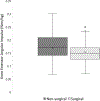Preoperative quadriceps weakness preferentially predicts postoperative aberrant movement patterns during high-demand mobility following total knee arthroplasty
- PMID: 30600199
- PMCID: PMC6377852
- DOI: 10.1016/j.knee.2018.12.005
Preoperative quadriceps weakness preferentially predicts postoperative aberrant movement patterns during high-demand mobility following total knee arthroplasty
Abstract
Background: Nearly all patients with total knee arthroplasty show aberrant movement patterns during tasks requiring greater joint demand compared to matched peers. Greater movement compensation leads to increased loading onto other joints, decreased functional capacity and limited reserve for independence later in life. Understanding how preoperative predictors contribute to postoperative aberrant movement patterns is needed to make better decisions for patients considering total knee arthroplasty.
Methods: Forty-seven patients were tested preoperatively and six months following primary total knee arthroplasty. Demographic (age, sex, body mass), self-reported (knee pain, perception of physical performance, physical activity level), physical performance (quadriceps strength, lower limb power and timed stair climbing) and surgical metrics were collected as predictor variables. Three-dimensional models based on joint mechanic asymmetry during a decline walking task were collected at six months postoperatively. Decline walking is a preferred means to assess the surgical knee's contribution to limb performance during high-demand tasks. Bootstrap inclusion fraction was employed to compare the stability of each predictor variable prior to the final regression model.
Results: Preoperative quadriceps strength (β = 0.33; p = 0.04) showed a significant relationship with knee extensor angular impulse during loading phase. No other predictor variable had any meaningful relationship with aberrant movement patterns (p > 0.05).
Conclusion: Our findings highlight patients' preoperative quadriceps strength as a meaningful predictor of postoperative performance. Preoperative quadriceps strength should be addressed when considering the knee's ability to contribute to higher demanding mobility tasks following surgery.
Keywords: Biomechanics; Decline walking; Gait analysis; Quadriceps strength; Total knee arthroplasty.
Published by Elsevier B.V.
Conflict of interest statement
Conflict of Interest Statement:
One of the authors certifies that he (CLP), or a member of his immediate family, has or may receive payments or benefits unrelated to this work, during the study period, an amount of USD 100,001 to USD 1,000,000 from Biomet, Inc (Warsaw, IN, USA).
One of the authors certifies that he (CEP), or a member of his immediate family, has or may receive payments or benefits unrelated to this work, during the study period, an amount of USD 5,000 to USD 100,000 from Biomet, Inc (Warsaw, IN, USA).
All other authors have no conflict of interest information to disclose.
Figures
Similar articles
-
Quadriceps weakness preferentially predicts detrimental gait compensations among common impairments after total knee arthroplasty.J Orthop Res. 2018 Sep;36(9):2355-2363. doi: 10.1002/jor.23894. Epub 2018 Apr 24. J Orthop Res. 2018. PMID: 29577425
-
Longitudinal study of knee load avoidant movement behavior after total knee arthroplasty with recommendations for future retraining interventions.Knee. 2021 Jun;30:90-99. doi: 10.1016/j.knee.2021.03.014. Epub 2021 Apr 17. Knee. 2021. PMID: 33878682 Free PMC article.
-
A prospective randomized trial examining the use of a closed suction drain shows no influence on strength or function in primary total knee arthroplasty.Bone Joint J. 2019 Jul;101-B(7_Supple_C):84-90. doi: 10.1302/0301-620X.101B7.BJJ-2018-1420.R1. Bone Joint J. 2019. PMID: 31256644 Clinical Trial.
-
Quadriceps strength in relation to total knee arthroplasty outcomes.Instr Course Lect. 2010;59:119-30. Instr Course Lect. 2010. PMID: 20415375 Review.
-
Preoperative Quadriceps Muscle Strength and Functional Ability Predict Performance-Based Outcomes 6 Months After Total Knee Arthroplasty: A Systematic Review.Phys Ther. 2019 Jan 1;99(1):46-61. doi: 10.1093/ptj/pzy118. Phys Ther. 2019. PMID: 30329137
Cited by
-
Artificial intelligence-based analysis of lower limb muscle mass and fatty degeneration in patients with knee osteoarthritis and its correlation with Knee Society Score.Int J Comput Assist Radiol Surg. 2025 Apr;20(4):635-642. doi: 10.1007/s11548-024-03284-y. Epub 2024 Nov 3. Int J Comput Assist Radiol Surg. 2025. PMID: 39489851 Free PMC article.
-
Current applications of gait analysis after total knee arthroplasty: A scoping review.J Clin Orthop Trauma. 2022 Sep 5;33:102014. doi: 10.1016/j.jcot.2022.102014. eCollection 2022 Oct. J Clin Orthop Trauma. 2022. PMID: 36110510 Free PMC article.
-
Prevalence and clinical burden of venous thromboembolic events (VTEs) in contemporary total knee arthroplasties (TKAs) in US hospitals.J Orthop. 2024 Oct 8;61:122-126. doi: 10.1016/j.jor.2024.10.006. eCollection 2025 Mar. J Orthop. 2024. PMID: 40051786
-
Gait mechanics are influenced by quadriceps strength, age, and sex after total knee arthroplasty.J Orthop Res. 2021 Jul;39(7):1523-1532. doi: 10.1002/jor.24878. Epub 2020 Nov 2. J Orthop Res. 2021. PMID: 33034899 Free PMC article.
-
Do Preoperative Vastus Medialis Volume and Quality Affect Functional Outcomes after Total Knee Arthroplasty?J Clin Med. 2022 Jun 23;11(13):3618. doi: 10.3390/jcm11133618. J Clin Med. 2022. PMID: 35806903 Free PMC article.
References
-
- Mizner RL, Petterson SC, Stevens JE, Axe MJ, Snyder-Mackler L. Preoperative quadriceps strength predicts functional ability one year after total knee arthroplasty. J Rheumatol. 2005;32: 1533–9. - PubMed



